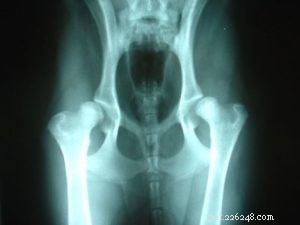動物がいつ痛みを感じているかを検出するのは難しい場合があります。結局のところ、動物はどこが痛いのかを示したり、痛みの種類を説明したりすることはできませんが、泣き言や喘ぎ声などの兆候は、何かが起きていることを示している可能性があります。最愛の子犬が苦しむのは最も避けたいことですが、ペットの痛みを和らげたいというこの欲求は、偶発的な中毒につながる可能性があります。 結論:イブプロフェンやアセトアミノフェンなどの人間用医薬品は犬用に設計されていないため、獣医師の承認なしに投与することはできません。

痛みの兆候は、次のような身体的または音声的なものである可能性があります:
あなたは自分の犬を誰よりもよく知っています。活動レベルや関心の急激な変化は、何かが起こっているという警告サインです。 ウォーキングなどの好きな活動を避ける またはフェッチをすることは、痛みのために運動したくない、または運動できないことを示している可能性があります。普段は友好的な犬がきびきびしたり、絶えず不機嫌になったりする場合、それは別の危険信号です。愛犬をいつ獣医に連れていくべきかを判断するのは難しい場合があります - 安くはありません 、私たちは知っています – しかし、潜在的な健康問題を早期に発見することは、ペットに可能な限り最良の結果をもたらします.
人間用の市販の鎮痛剤には、主に次の 2 つの形態があります。
いいえ、獣医が推奨し、厳密な指示がない限り、犬に人間特有の抗炎症剤をいくらでも与えることは安全ではありません.これらの薬は人間用に処方され、腎臓や消化管などの体の他の部分に影響を与えます.
犬に間違った用量を与えるのは簡単で、致命的になる可能性があります.正しい量を与えられたとしても、一部のペットは次のような副作用を経験する場合があります:
いいえ。イブプロフェンやアスピリンと同様に、これらの医薬品は人間用に処方されたもので、犬の腎臓や肝臓に損傷を与える可能性があります。タイレノールの量に関係なく、ペットに大きな害を及ぼす可能性があります.
犬のアセトアミノフェン中毒は一般的であり、この薬は猫にとって非常に有毒であるため、通常の強度の錠剤 1 錠でさえ死に至る可能性があります。深刻な肝臓と腎臓の損傷は、アセトアミノフェンの過剰摂取に起因する可能性があるため、獣医の同意なしにこの薬を投与しないことが重要です.アセトアミノフェンの副作用には次のようなものがあります:
中毒が十分に深刻な場合、タイレノールはあなたのペットをショック状態にしたり死に至らしめる可能性があります.
ペットの親である DeeDee は、2 歳の Goldendoodle Bentley が未知の量の薬物を摂取したときに、イブプロフェン中毒の恐怖を経験しました。 “It was a horrible time in our family’s life,” she said on Dr. Doug Kenney’s “Pet Insurance Guide” podcast . Bentley ended up with kidney failure and spent two days in the ER, but he’s since made a full recovery and is now enjoying life as a therapy dog.
If you suspect your dog or cat has ingested an over-the-counter painkiller, take the situation seriously. Contact your vet or local animal emergency clinic immediately.
To ensure that your dog or cat don’t get into pain medications accidentally, keep them on a high shelf, in the tamper-proof containers they came in. Or put child (and pet-proof) locks on any cupboard they can reach. Don’t leave medications sitting out, or in a purse or backpack that your pet might access.
If you suspect your dog or cat has ingested an over-the-counter painkiller, take the situation seriously. Contact your vet or local animal emergency clinic immediately.
While human-grade pain relievers are not recommended for pets, fortunately, there are options for dogs that are safe.
Drug companies have formulated certain medications specifically for dogs and cats that are much safer than over-the-counter pain medications meant for humans. Common medications prescribed for dogs include carprofen, etodolac, and meloxicam. Your veterinarian can prescribe one of these at a safe dose for your pet’s specific needs.
Carprofen (brand names such as Rimadyl® and Zinecarp®) is an FDA approved NSAID to treat dogs for pain and inflammation. It is recommended to give with food to prevent upset stomach and usually takes effect within 1-2 hours.
This medication, commonly known by the names EtoGesic® and Lodine®, is another NSAID specifically used for dogs to treat pain and inflammation associated with arthritis, fever, and post-surgery.
This NSAID, brand names such as Metacam® Loxicom®, OroCAM®, Rheumocam, is used to treat pain, inflammation, and fever in dogs. It may be used to treat arthritis or post-surgery.

Your veterinarian is the most qualified person to answer that question, but there are plenty of non-medical treatments, also known as alternative care , for a dog suffering from chronic pain:
Create a treatment plan with your vet that you and your pet are comfortable with (some pets refuse to take medication and others can be terrified of acupuncture). Healthy Paws covers alternative care such as acupuncture, chiropractic therapy, and hydrotherapy, as long as the procedure is performed by a licensed veterinarian. Enrolling your dog in pet insurance early on, before any problems occur, is the best way to be prepared for an unexpected accident or illness, and allows you to pursue the best treatment available without having to worry about the cost.
Many pet parents give their dogs or cats glucosamine to help ease those creaky, arthritic joints. Although many websites and pet homeopaths allege that certain “herbal pain remedies” are safer or more reliable, there is no scientific data to back up these claims. A 2006 study found glucosamine/chondroitin supplements can relieve pain related to osteoarthritis in dogs, but some vets are still skeptical, saying it has “some value, little risk.”
CBD oil, however, has been making headlines of late as helping alleviate pain, discomfort, increase appetite, and help with anxiety in pets, so asking your vet is a good first step. Check out our article CBD Oil for Cats and Dogs to find out more about how it works and what pet-friendly brands are out there.
Notably, a study by Cornell University’s College of Veterinary Medicine reported that CBD oil provided significant pain relief to dogs with arthritis, allowing the dogs to be more physically active. Veterinary research on CBD oil is only just beginning, so there’s still a lot more to learn about how CBD oil can help pets who are in pain.
Because NSAIDs, even those specifically prescribed to dogs, can cause unwanted side effects such as upset stomach, some pet parents may opt to try a more natural approach first. There are a number of herbal supplements that can safely aid pain management in dogs.
Comfrey has long been used as a traditional healing herb for a number of ailments, including pain, digestive issues, and cancer. It can help manage joint pain due to its anti-inflammatory and pain-relieving properties.
Turmeric is an orange root that has natural anti-inflammatory and antioxidant properties. It is best absorbed when consumed with black pepper and some fat, such as peanut butter or coconut oil. Learn more about how to make turmeric paste and dosage for your dog based on body weight.
Ginger , like turmeric, is a root that has many healing benefits and is safe to give to dogs. A 2010 human study showed that gingerol, the active ingredient in ginger, can reduce pain and inflammation in humans with rheumatoid arthritis.
Licorice root has anti-inflammatory compounds that can help reduce joint pain and arthritis symptoms as well as improve digestion and respiratory function. In large quantities or with daily use, it can have unwanted side effects, so speak with your veterinarian before giving it to your pet.

The root of a pet’s pain is not always immediately apparent. While in some cases the cause may be obvious – a broken limb or post-surgery – most of the time the animal is suffering in silence. Sometimes the pain’s location can be difficult to identify. For example, visceral pain, such as abdominal pain, can be challenging for a vet to pinpoint. Pay attention to any changes in your dog’s behavior, especially in senior pets and after medical procedures. Some pain in dogs appears only after certain kinds of activity, like hiking or high-intensity exercise, or as a result of actions like eating or going potty.
Chronic pain: Degenerative diseases like osteoarthritis and degenerative myelopathy, which affects the spinal cord, are more likely to arise in senior dogs and can be very painful if left untreated. Dog hip pain is the most common type, frequently caused by canine hip dysplasia or arthritis. Intervertebral disc disease (IVDD) occurs more often in certain dog breeds, like Dachshunds and Shih Tzus, commonly known as a “bulging” or herniated disc.
Acute pain: In addition to incident-related injuries or broken bones, internal pain can be acute and needs immediate vet attention. For example, stomach pain can indicate a serious medical condition like peritonitis, an infection of the stomach or intestines caused by a puncture (chicken bone splinters and swallowed objects are common culprits). A stomach virus, or enteritis, can also be to blame, caused by parasites and worms in dogs . Tumors and some types of cancer in dogs can also lead to stomach pain as the disease progresses, so catching cancer early is of utmost importance.
The content is not intended to be a substitute for professional veterinarian advice, diagnosis, or treatment. Always seek the advice of your veterinarian or other qualified health provider with any questions you may have regarding a medical diagnosis, condition, or treatment options.

犬の飼い主は、親友が苦しんでいるのを見たいとは思っていません。しかし、私たちの犬は生涯を通じて痛みを経験します—私たちが痛みを経験するのとほぼ同じ頻度で、同じ理由の多くで。そして、私たちが痛みを感じているときにタイレノールとアドビルに手を伸ばすのと同じように、犬の痛みを和らげることは私たちの毛皮のような友人を助けることができます。 人と同じように、犬は急性と慢性の2種類の痛みを経験します。急性の痛みは短期的なものであり、病気、感染症、怪我が原因で発生します。たとえば、耳痛は犬の急性の痛みの一般的な原因です。慢性的な痛みは長期的です。これは、慢性関節痛を引き起こす変形性関節症のような根本的な

疫病はの発生です ペスト菌による細菌感染 (PDF)、犬を含む潜在的な宿主に感染する寄生細菌。感染は特定の国や地域に固有のものではなく、世界中で発生する状態です(ただし、第三世界の国々でより多く見られます)。米国では、細菌は国の南西部で5月から10月の間に最も頻繁に見られます。 犬は人間よりも細菌の影響を受けにくいため、犬のペストは非常にまれです。犬はペスト菌に対してより高い耐性を持って生まれます。とはいえ、犬が感染する可能性はあり、すべての犬はこの細菌感染に対して等しく脆弱です。性別、品種、年齢に基づく素因はありません。 犬の疫病とは何ですか? 他の細菌感染症とは異なり、ペットの飼い